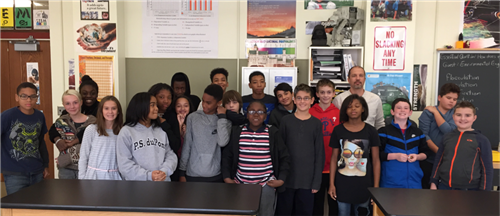-
ENVIRONMENTAL ENGINEER VISITS STEM
 On Friday, October 21 and again on Wednesday, October 26, Environmental Engineer Joseph Nattress joined Mr. Fawks's STEM classes to help students better understand the field of Environmental Engineering, especially the process for making water consumable. Students learned about flocculation, coagulation, sedimentation, clarification, filtration and disinfection as Mr. Nattress walked each class through the entire process.
On Friday, October 21 and again on Wednesday, October 26, Environmental Engineer Joseph Nattress joined Mr. Fawks's STEM classes to help students better understand the field of Environmental Engineering, especially the process for making water consumable. Students learned about flocculation, coagulation, sedimentation, clarification, filtration and disinfection as Mr. Nattress walked each class through the entire process.Flocculation and Coagulation
Flocculation, in the field of chemistry, is a process wherein colloids come out of suspension in the form of floc or flake; either spontaneously or due to the addition of a clarifying agent. Due to the clarifying agent, the particles in the water coagulate together forming larger floc. Coagulation and flocculation are important processes in water treatment.Sedimentation and Clarification
Sedimentation is a physical water treatment process using gravity to remove suspended solids from water. Clarifiers are tanks built with mechanical means of continuous removal of solids being deposited by sedimentation. Sedimentation and clarification are important processes in water treatment.Filtration
As a part of the STEM activity, students built a working prototype filter with the following materials: empty water bottle, rubber band, coffee filter, rocks, sand and anthracite. Students first ran water through the filter to prepare the filter for actual use. Once the filters were conditioned, each team ran a sample of the water that had undergone flocculation, coagulation and clarification steps through their filter. Comparison of the clarified water and the filtered water was a quick means to identify how much cleaner the water had become from the initial dirty water where the process began.Disinfection
Water disinfection means the removal, deactivation or killing of pathogenic microorganisms. This is an extremely important process in water treatment. Without disinfection, people would become ill and possibly die as occurred in the past because of contaminated water. As a class, we did not disinfect the water because of the danger of working with chemicals. It is important to note that chlorine and oxides are used in this process at the water treatment plant prior to the water being sent out for use.Additional Photos
A very special thanks goes out to Mr. Nattress for visiting Mr. Fawks's STEM classesand for sharing his expertise as an environmental engineer.
Select a School...
Select a School
- Brandywine High School
- Carrcroft Elementary
- Charles W. Bush Pre-School
- Claymont Elementary
- Concord High School
- Forwood Elementary
- Hanby Elementary
- Harlan Elementary
- Lancashire Elementary
- Lombardy Elementary
- Maple Lane Elementary
- Mt. Pleasant Elementary
- Mt. Pleasant High School
- P.S. duPont Middle School & ECAP
- Springer Middle School
- Talley Middle School

